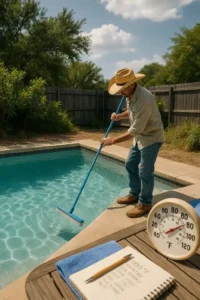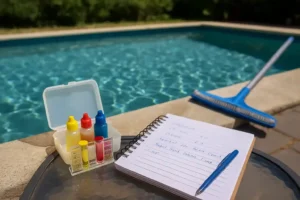It’s mid-July in Texas. You walk out with your morning coffee, expecting to see a shimmering blue oasis… but nope—your pool’s gone green. Thick, cloudy, algae-green. It smells weird. It looks worse. And you wonder: “Did I miss something?”
If that resonates with you, you’re not by yourself. In Texas, pool owners are very focused on preventing and removing algae. The distinctive climate—strong sunlight, dust, moisture, and frequent usage—forms an ideal environment for algae growth.
Today, we are exploring how to prevent it from beginning and how to address it if it’s already settled in.
 Why algae loves texas pools
Why algae loves texas pools
Algae is sneaky. And Texas gives it a red carpet welcome.
- High UV Exposure: The sun depletes chlorine faster, which weakens your pool’s defense system.
- Dust & Pollen: These act like organic fuel for algae, especially after windstorms or heavy mowing nearby.
- Warm Water: Algae thrives above 85°F. Texas summers practically invite it to party.
- Pool Traffic: More swimmers mean more contaminants—body oils, sunscreen, dirt.
All of these factors combine to make algae prevention and removal in Texas not just important—but absolutely essential.
Signs of algae before it takes over
Don’t wait until the water turns Hulk-green. Catching algae early makes all the difference.
Look for:
- Cloudy or hazy water
- Slippery or slimy pool walls
- Slight green or yellow tint (especially in corners)
- Filter pressure increases for no clear reason
Early detection is your best friend in the world of pool algae control.
The pro’s weekly routine to prevent algae
Consistency beats intensity every time. Here’s a breakdown of a deep clean-based weekly routine used by top pool technicians in Texas:
1. Daily quick checks
- Skim off leaves and pollen
- Visually check for water clarity
- Test water temp (algae loves warmth)
2. Twice weekly testing
- Chlorine (3–5 ppm in summer)
- pH (7.2–7.6)
- Alkalinity (80–120 ppm)
- Cyanuric acid/stabilizer (30–50 ppm)
3. Weekly brushing & vacuuming
- Focus on steps, corners, and ladders
- Use a nylon or stainless steel brush (depending on surface)
- Vacuum thoroughly or use an automatic cleaner
4. Shock after parties or rain
- Use non-chlorine shock for regular maintenance
- Chlorine shock for active outbreaks
5. Clean filters monthly
- Cartridge: rinse and deep clean
- DE: backwash and recharge
- Sand: backwash thoroughly
By following this, you’ll significantly reduce the chances of dealing with a green pool nightmare.
Deep clean: What to do when algae takes over
Already too late? Pool looks like swamp water? Time to bring in the heavy-duty steps.
Step-by-Step deep clean process
- Brush everything: Dislodge algae from walls, steps, tiles.
- Shock hard: Triple the dose of chlorine shock. Do it at dusk.
- Run filter nonstop: 24–48 hours straight. Backwash every 6–8 hrs.
- Vacuum to waste: If possible, vacuum algae out of the system entirely.
- Algaecide: Use a copper-based one AFTER chlorine level drops below 5 ppm.
- Rebalance: Once algae dies, rebalance pH, alkalinity, and chlorine.
- Repeat if necessary: Severe cases need more than one round.
Deep cleaning is labor-intensive, but it’s the only way to recover a truly compromised green pool.
 Pro tips to stay algae-free all summer
Pro tips to stay algae-free all summer
- Use a pool enzyme weekly to break down oils and organics
- Rinse swimsuits before entering pool
- Keep trees trimmed to reduce shade and debris
- Don’t rely solely on chlorine—balance is key
- Consider UV or ozone systems as extra defense
Algae prevention and removal in Texas isn’t just about fighting the green stuff. It’s about building habits, using the right tools, and staying one step ahead.
The emotional toll of a green pool (Yes, Really)
Let’s be real. A murky pool isn’t just ugly. It’s embarrassing. You cancel a BBQ, skip your morning laps, and feel like your oasis betrayed you.
I remember the summer of ’21. We were hosting a birthday party. The balloons were up, the playlist ready, burgers on the grill. And the pool? A murky disaster. I’d skipped brushing. One week. That’s all it took.
After that? Never again.
Algae prevention and removal in Texas became my religion. I got smart, got organized, and got a water sensor. Haven’t had an outbreak since.
Algae prevention and removal in Texas isn’t just about pool aesthetics. It’s about safety, peace of mind, and reclaiming your summer weekends.
Consistency is your best weapon. Brushing, testing, shocking, filtering—these aren’t chores. They’re your way of saying, “Not today, algae.”
And hey, if you’re serious about mastering pool care, you’ll love our article on Weekly Summer Maintenance in Texas. It pairs perfectly with this one—like chlorine and sunlight.
So grab your brush, test kit, and a cold drink. Your pool’s waiting.
FAQs About Algae in Texas Pools
1. What causes pool algae in Texas specifically?
Texas heat, UV radiation, dust, and high swimmer loads are the top culprits. They weaken chlorine levels and introduce organic debris—fuel for algae.
2. How often should I shock my pool in summer?
Once weekly in extreme heat, or after storms, heavy usage, or if water starts to cloud. Always shock at dusk.
3. Can I swim in a green pool?
Technically, yes. But you really shouldn’t. It can harbor bacteria and is a sign your water is unbalanced.
4. What’s the fastest way to kill algae?
Brush everything, triple shock, run the filter nonstop for 48 hours, then balance chemicals. It’s aggressive, but it works.
5. Do saltwater pools still get algae?
Yes. Salt systems generate chlorine, but you still need to balance, brush, and test regularly.
